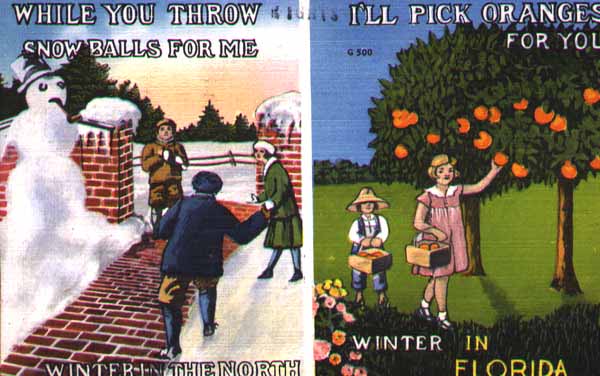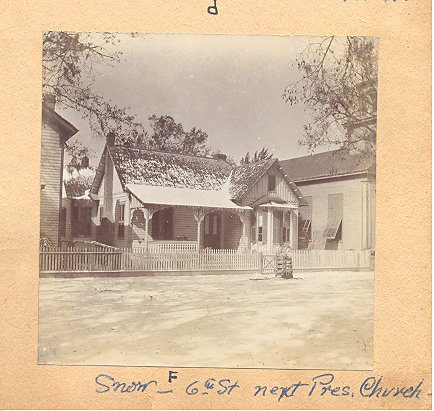
Sun, Sand, and Snow: Winter Weather on Amelia Island
January 8, 2024by Jarrett Hill
 Sweet, Ozzie. Three girls making a “sandman” at the beach. 1964. State Archives of Florida, Florida Memory. <https://www.floridamemory.com/items/show/81583>.
Sweet, Ozzie. Three girls making a “sandman” at the beach. 1964. State Archives of Florida, Florida Memory. <https://www.floridamemory.com/items/show/81583>.
Since Florida’s modern era of tourism began at the turn of the 20th century, the state has presented itself as a sunny escape during the cold winter months. Postcards from the early 1900s entice Northerners with an alternative to their frozen surroundings, teasing “while you throw snowballs for me, I’ll pick oranges for you.” Midcentury tourism images put out by the Florida Department of Commerce show smiling beachgoers building “snowmen”, having swapped snow for sand and a scarf for a starfish. The idea of Florida as a refuge from cold has even spread to the language used to discuss the state’s growing seasonal residents, commonly known as “snowbirds”.
 While you throw snow balls for me, I’ll pick oranges for you. 1945 (circa). State Archives of Florida, Florida Memory. <https://www.floridamemory.com/items/show/157559>.
While you throw snow balls for me, I’ll pick oranges for you. 1945 (circa). State Archives of Florida, Florida Memory. <https://www.floridamemory.com/items/show/157559>.
But that reputation is not a guarantee, and winter weather does not always stay away from the Sunshine State. As warm air begins to rise and flow away from ground level, it draws in the surrounding atmosphere. When this happens on a large scale, and fronts of cool winter air descends to replace the warm air, powerful invasions of cold weather may occur. While uncommon, these outbreaks of cold can produce below-freezing temperatures and wind chills. Over the past 250 years, numerous severe cold outbreaks have affected Florida.
Snow in Early Florida
The earliest recorded instances of winter weather in Florida present the weather as a peculiar amusement. In 1774, a snowstorm extended across Florida, with the British East Floridians living in what is now Duval County describing an “extraordinary white rain” falling over their settlement. Despite these whimsical accounts, the year-round agricultural growing season that the Florida economy depended on at the time was monitored closely during snowfall. A report on the climate of British East Florida states that on December 19, 1765, there was a “fall of snow in the northern part of the province, which was of short duration, and of no material detriment to the agricultural interests.” However, the harmlessness of that year’s winter was disputed. John Bartram, the botanist and father of William Bartram, kept a climate log along the St. John’s River and marked a rapid dip in temperature, from 74 degrees down to 26 degrees, in only 10 days. He claimed that the coldest of these nights—January 5th, 1766—was the “fatal night that destroyed the lime, citron, and banana trees in St. Augustine”, and that the ground was frozen an inch deep along the banks of the St. Johns River.
 .
.
 Freeze of February 1899. February 1899. Photographic print. Elizabeth Swann Carroll collection, Amelia Island Museum of History.
Freeze of February 1899. February 1899. Photographic print. Elizabeth Swann Carroll collection, Amelia Island Museum of History.
This concern continued into the 19th century, when unprecedented consecutive freezes decimated the North Florida citrus industry and permanently relocated it to the central and southern parts of the state. The final freeze of the century, 1899’s “Great Arctic Outbreak”, coincided with the rise of personal photography equipment for wealthy individuals, who used the new technology to document the unusual weather. The images above were taken by the family of notable Fernandina resident Samuel Ashe Swann (1832-1909) and capture the quiet wonder of a subtropical beach town under an unexpected blanket of white. In these early photographs, Fernandina’s Victorian architecture is dusted with snow and the windows of the First Presbyterian Church have been left open overnight! Other images show early electric light fixtures on Centre Street, dangling over a white street sparsely filled with pedestrians.
 Christian, Ruby. “Snow, ice hit Amelia Island”, Fernandina Beach News-Leader. December 27, 1989. https://original-ufdc.uflib.ufl.edu/UF00028319/02279/1x
Christian, Ruby. “Snow, ice hit Amelia Island”, Fernandina Beach News-Leader. December 27, 1989. https://original-ufdc.uflib.ufl.edu/UF00028319/02279/1x
 Snow on Centre Street, 1989. December 25, 1989. Photographic postcard. Amelia Island Museum of History.
Snow on Centre Street, 1989. December 25, 1989. Photographic postcard. Amelia Island Museum of History.
Fernandina Beach’s White Christmas
The serenity of Fernandina in the Swann family’s photography was not present during Amelia Island’s most recent major snow event. On December 22, 1989, an evening rain slowly turned into sleet, then snow. When residents awoke the next morning, they found Fernandina Beach covered in what the Fernandina News-Leader described as an “uncommon carpet” of snow, 1-2 inches deep. With many residents unadapted to daily life in snowy conditions, reports from December 23rd describe an island in mild chaos. Grocery store employees responsible for returning carts from the parking lot were seen “skidding about on the ice”, while routine chores, like taking out the garbage, required residents to carefully tiptoe down their icy driveways. Many residents embraced the rare opportunity, transforming the sandy 18th Street hill into a makeshift sledding slope. For children, “making snowballs had to be on the installment plan. They could not bear to dip their hands in the frozen material for long.”
Bridge access to the island had to be shut down, as well as the municipal airport, whose runways had iced over. As a result, only 2 of the 42 expected holiday guests at the Amelia Island Plantation arrived, according to resort manager Jack Healan. Workers living off-island had to stay overnight at friends’ houses because of the bridge closures. However, because of the proximity to the winter holidays, last-minute shoppers still took to the road, making the usual final trips to the store for holiday food and gifts. This insistence may have been part of the reason that, in a single day, local police reported over 200 car wrecks and 90 vehicles stuck in roadside ditches.
Ice and snow lingered in some shaded areas of town for up to seven days. Despite the disorder of Fernandina Beach’s white Christmas, the novelty of the experience inspired residents to create postcards of the snow-coated town. These postcards, some of which are displayed above, starkly contrast with the expectation of a beach resort town and the winter-proof Florida sold to Northerners at the turn of the century.
If you have a chance, ask longtime locals about their memories of December 1989’s week of snow!
__________
References
While you throw snow balls for me, I’ll pick oranges for you. 1945 (circa). State Archives of Florida, Florida Memory.
Sweet, Ozzie. Three girls making a “sandman” at the beach. 1964. State Archives of Florida, Florida Memory.
Forbes Grant, James. Sketches, historical and topographical, of the Floridas : more particularly of East Florida. New York: C.S. Van Winkle Press, 1821. Pages 60-61. https://archive.org/details/sketcheshistoric00forb/page/60/mode/2up.
DAVIS, T. FREDERICK. “CLIMATOLOGY OF JACKSONVILLE, FLA., AND VICINITY”, Monthly Weather Review 35, 12 (1907): 566-572.
Freeze of February 1899. February 1899. Photographic print. Elizabeth Swann Carroll collection, Amelia Island Museum of History.
Christian, Ruby. “Snow, ice hit Amelia Island”, Fernandina Beach News-Leader. December 27, 1989. https://original-ufdc.uflib.ufl.edu/UF00028319/02279/1x.
Snow on Centre Street, 1989. December 25, 1989. Photographic postcard. Amelia Island Museum of History.





